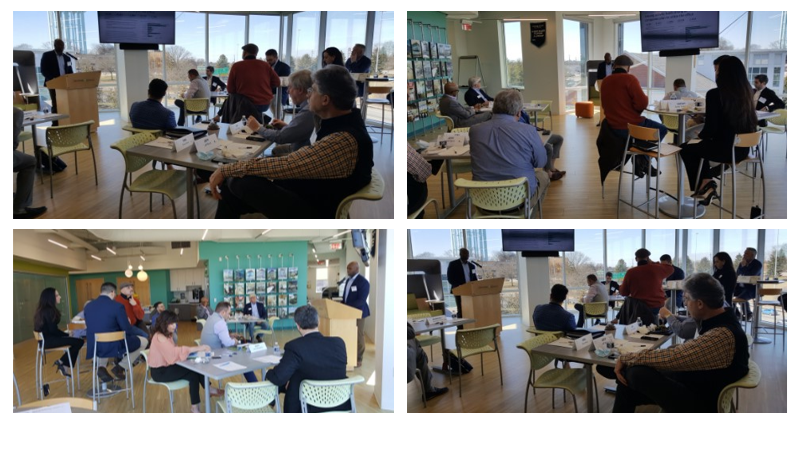Pittsburgh February 2022 – Key Take-Aways
Mamadou Balde, Managing Director, CBRE provided a market overview:
Office:
Leasing activity is holding strong – up nearly 3 percent [year to date]. Total vacancy rate is up 16.8 percent, and overall asking rent is up $23. The highest asking rates are in the Oakland/East End, where rates have held over $36 per SF throughout 2020 and 2021.
The Downtown fringe submarket experienced a 44.3% increase in leasing activity, year over year, making it the most active submarket in Pittsburgh in 2021.
We’re finding that many anchor office tenants are moving out, and that’s a trend across the country. It’s almost a necessity now to have amenities; activity is moving toward Class A developments. There’s some worry that deals won’t be made in the lower-class properties, so some landlords are giving concessions. Tenants are looking for quality and price.
On the occupier side, activity is improving since 2021. Among the biggest tenants in the Downtown fringe market are GNC Holdings, which leased 76,000 SF in 75 Hopper Place; Argo occupied 24,480 SF in 2545 Railroad St.; Allegheny Technologies will occupy 18,875 SF in The Vision on Fifteenth; and Civil and Environmental Consultants has signed the largest office lease of 2021 in the Pittsburgh market: 121,114 SF in the Parkway West at 700 Cherrington Pkwy.
Industrial
Asking rents are increasing as strong demand for space persists. The biggest thing to note is that overall asking rent increased by 6.4%, quarter-over-quarter, from $6.77 to $7.20, and we’re going to continue to see increases in price. Pittsburgh posted the highest average asking rates in the Midwest; the region’s average is $5.30. The vacancy rate is up 6.9 percent. The industrial market in Pittsburgh experienced approximately 4.9 million SF of total leasing activity in 2021, an increase of 38.3% over 2020. Our issues on top of inventory and topography are supply chain issues. Some highlights: The West and Westmoreland County were the most active submarkets in terms of total leasing activity for 2021. Among the bigger deals, Nogin signed to take 257,991 SF at 2250 Roswell Dr.; Intervala signed to take 227,000 SF at 1001 Technology Dr. in Westmoreland County; and Goodblend occupied 120,000 SF at 2920 New Beaver Ave.
Multifamily
This is a very hot product here, vacancies hit historic lows during the pandemic, at 4.4 percent, and Pittsburgh now is pushing $1,200 in rent. There are 2,960 units under construction, an increase of 861 units year over year. Victrix is pursuing redevelopment of the GNC Building on Sixth Avenue into a 236-unit apartment building. Among the bigger sales, Brookfield Real Estate Investment Trust purchased Southside Works City Apartments, a 264-unit property, for $90 million — which translates to more than $340,000 per unit. Our forecast shows that rents will continue to go up.
Retail
Occupancy levels and market rents pushed higher amid pandemic concerns. Total vacancy rate is down 3.9%; strong demand has tightened supply. The average space leases for close to $15.50 SF, and retail space in malls is leasing for close to $22 per SF. Rents in power centers are close to $18 SF, and in neighborhood centers, it’s close to $15.30.
Some trends: Local restaurants struggled, but others have benefited from third-party delivery services. All the pent-up demand during the pandemic is finally being realized here in 2022. While people are returning to offices, many restaurants and retailers in the heart of the city closed during the pandemic. So, after all the insanity of the pandemic, retailers and restaurants are starting to feel a little more comfortable, although there is the added stress of service workers changing industries. The silver lining [to the pandemic] is, with the shutting down of some restaurants, there’s opportunity for brokers to put available properties on the market.
Pittsburgh trends — we have five key sectors: Finance, energy, manufacturing, life sciences and technology. We’re the #2 best city in America for jobs … #3 startup city in the Midwest … #6 best city for economic development. We’re known as “America’s affordable tech town” and we’re still a leader in health care. 10 Fortune 500 and 17 Fortune 1,000 companies have headquarters in the area. Life sciences and technology keeps Pittsburgh on track for the future. More than 9,800 tech firms have a foothold here. Tech jobs have increased 29 % over the last decade.
Scott DiGuglielmo, Burns Scalo: We’re trying to create an ecosystem in the city, county and state; what we need to do is to put everything together. Life sciences is quite the buzzword in Pittsburgh, but other cities are passing us by. In Cambridge, there’s 24 million SF of office space and they need 10 million more. They’re getting $110 to $130 SF in rents, and office rents of $80 to $95 SF. We do have the fundamentals here [including] hybrid working. In Boston, companies have found they need to make their offices a magnet, rather than a mandate. It’s “flight to quality”: Make people want to come to the office, or people will look for other places to work. There are companies offering flexible work options.
Tom Frank, Desmone Architects: Doing a lot in commercial, multifamily and retail. The West Virginia office is doing more than Pittsburgh in ground-up [development]. In the industrial sector, we’re doing a fair amount of work.
Jim Futrell, Allegheny Conference on Community Development: I know I’m starting to sound like a broken record, but the regional economy is in a slow, steady slog that we’re going through to get back to pre-pandemic employment levels. There’s not a lot of movement. The slow population growth here serves as a counterweight on economic activities. There are still five industries that are most challenged: mining, manufacturing, and wholesale trade and other services and leisure and hospitality. We’ve been seeing good trends with arts and entertainment getting back to pre-pandemic levels; that happened in the fall when the Cultural Trust started hosting events. And food services is slowly coming back; it didn’t experience the December downturn that it usually does, but it’s still about 60 percent of pre-pandemic level. We need more business travel before that comes back.
Jeff Burd, Tall Timber Group: Tracks the residential market and 4th quarter last year and the year before, my numbers were consistently wrong; I forecast mostly what’s in the pipeline. I don’t have to look that far out. But I was wrong in the direction I wasn’t accustomed to: There was more construction than I expected. PPP did more than I expected. Small businesses did a lot, made a lot of money, small manufacturers. Business came back and had a pile of cash from PPP. “Invest in your own business” made a lot of sense. There was a relatively large increase in owner-occupied, particularly outside Allegheny County or Pittsburgh proper, with 10,000 to 40,000 SF new buildings or expansions. What might stop that are two things: 1) Costs, especially in light construction; contractors are optimistic people and for a while, we were getting higher prices, historically, bidding prices lag 6 to 8 months but they’re no longer lagging. If you didn’t like last year’s prices, you won’t like this year’s. And 2) supply chain issues. It ain’t getting fixed. I can’t see anything happening before the 4th quarter. It’s kind of surprising. Things you wouldn’t think about, such as HVAC equipment, is taking 14 weeks instead of 14 days. There are hiccups we’ve never experienced. For those on the brokerage side, waiting won’t be the answer — unless
Louis Olivia, Newmark Grubb Knight Frank: All of a sudden, industrial’s in fashion. It’s an exciting time. Industrial’s been steady the last 10 years; the last five years, we finally have active speculative developers and inventory on the market. Pittsburghers traditionally don’t like change, but it’s not all Amazon. There are a lot of other folks. Light manufacturing, that uses less employment, but the big risk is increase in pricing and the time frame to deliver. A lot of occupiers are looking.
Pamela Austin, Burns Scalo: Among the trends we’re seeing is in fitness, and lots of entertainment — experiential entertainment. Lots of things in the process right now, including retail and the Terminal is filling out. In housing, there’s a lot of development on the riverfront, stretching into Lawrenceville, so that trend continues.
Nathan Pazsint, SVN Three Rivers Commercial Advisors: There’s more happening now, [properties] changing hands, things getting done, than I can remember in a long time. That’s something we can all tap into. I’m seeing the change to amenities-driven framework in multifamily and Downtown. Also have two big industrial projects. There are hungry executives looking.
Von Eric Fisher, VP-Industrial: I’m a 20-year consultant in industrial development; worked on Bakery Square and other big projects. Distribution and hardcore industrial. Distribution is what’s really blowing up. In hardcore industrial, we’re seeing huge push from a lot of companies bringing facilities, not just one company, but multiple companies. So it’s coming back as well. On the tech side, there are so many multiple aspects. We’re growing not just as a city and county, but becoming a tech region. It’s a really exciting time; there’s a lot more going on than people realize.
Ray Steeb, eFacility LLC: A lot of things resonated today. I think the movement back to offices will be faster than you know. As an owner, you find your promotions are the people you know, not the people you don’t know. So, when the people who are working from home realize that, you’ll see them wanting to come back to the office. And prices are slowly going up — and will never come down. Anybody talking to a customer, it’s only going to get worse; it’s never going to get better [in terms of prices]. With the supply chain, our facility customers are seeing eight to 10 months for delivery of parts, and that’s a problem. Some are going from place to place, taking parts of things and putting on others. Labor is also harder to find – especially with younger people not working with their hands. Our customers are telling us that losing they’re institutional knowledge






Recent Comments